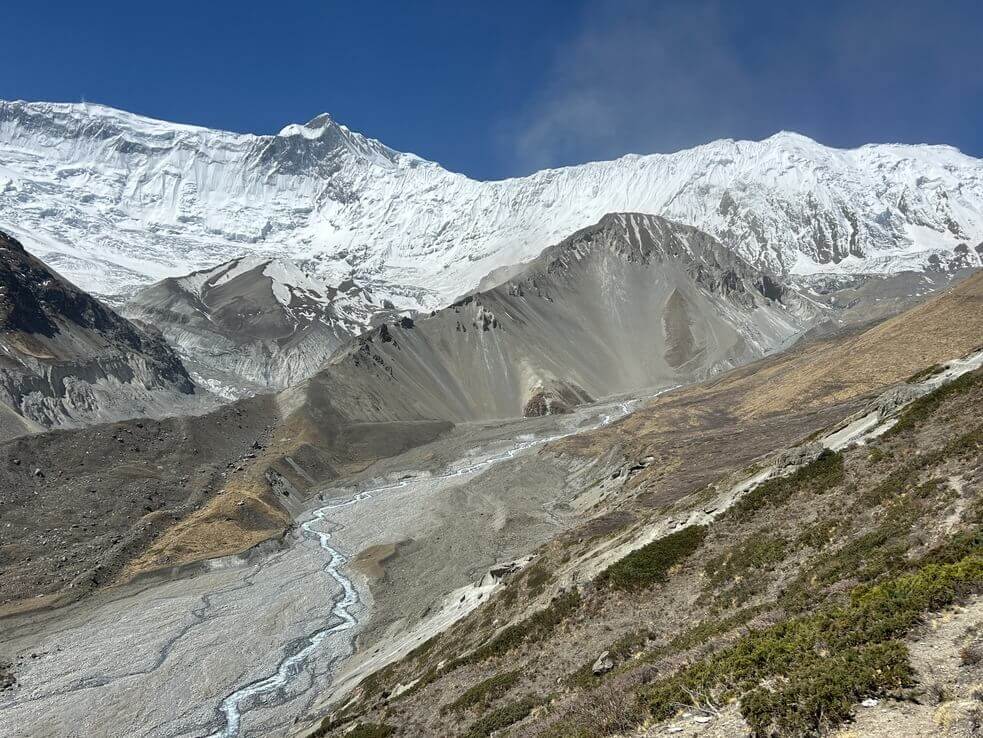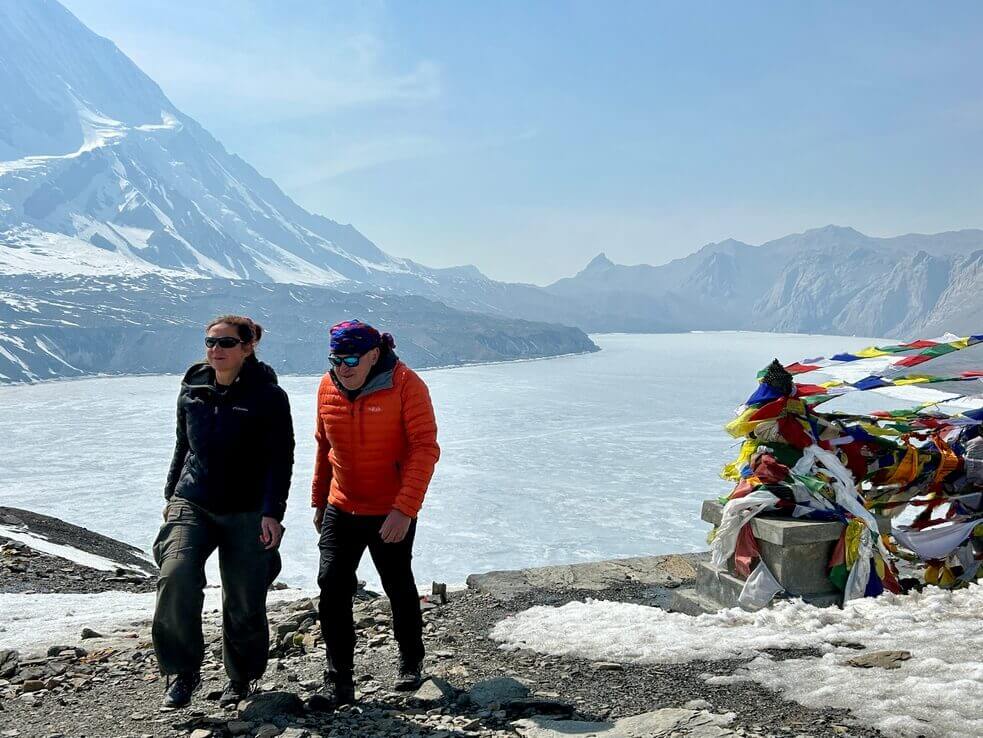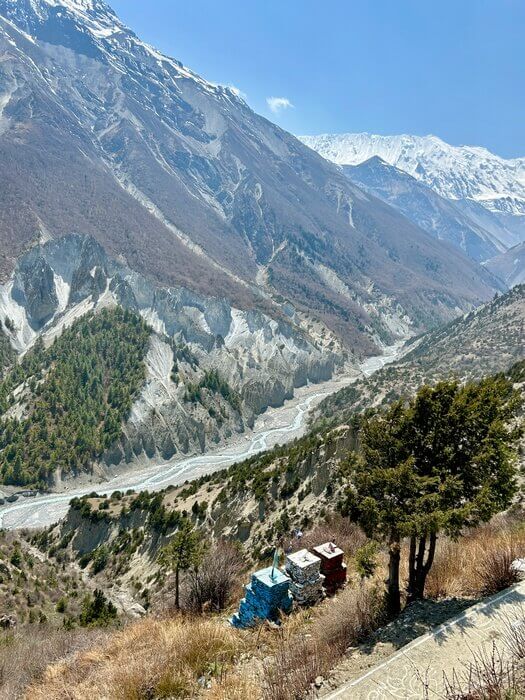“I heard that the road to Manang is a challenge” says Juvena @thewanderingwasp when I told her where we were heading today.
Hmmm, well, we’ll see. For now, we are driving on good tarmac road from Begnas Lake towards Besisahar – the gateway to the eastern part of the Annapurna trekking circuit. From there, it’s only 103 km to Khangsar – an old village where the passable road ends. We want to do a two-three day trek to Lake Tilicho.
We hadn’t checked what kind of road it was, so we only know that from the main road we have about 75 km to go. Turning onto a gravel road immediately confirms Juvena’s words. The track is narrow, potholed, sometimes rocky, sometimes sandy, crisscrossed with water ruts, with a full portfolio of rough patches. We pass small villages and climb a rocky shelf high above the Marsyangdi River. Our pace is steadily slow – we cover about 20 km in an hour. And we are the fastest on this road – we pass a few jeeps and some locals, but no one overtakes us. Just before Jagat, the road is blocked by a traffic jam. A jeep on a switchback either reversed too far or lost its brakes and ended up off the road. Now the locals are trying to pull it out with a tractor, and whoever comes along has to stop and wait.
Dusk has already come, and we know we need to set for the night. A quick decision – we go back to the previous village and find a pleasant blue-pink lodge. The life of the villages along this road is completely dependent on tourists. The cultivation of small plots on the slopes and animal husbandry provide food supplies, but they are not easily monetized in this area. Therefore, whoever has space and can, opens a lodge. They feed and host trekkers traveling the trail around Annapurna.
The next day we head north. Everyone says the road will get better after Jagat. Yes, there are long concrete sections here, but you still need to be careful – especially at the joints between the concrete and what’s underneath – because there are usually the biggest holes and sharp edges. The climbs are so steep that the motorcycle easily goes on the rear wheel, so we practically hang over the tank. You also need to be careful when catching up with jeeps because they kick up a lot of dust and are not always keen to let a smaller vehicle pass.
Finally, the landscape flattens out. We ride between apple orchards and even stop at the only eco-apple-resort to try the local apple pie.
Late in the afternoon, we arrive in Khangsar. It’s cold and windy here. Most trekkers choose Manang – a larger village 5 km away- as their base, but for us, peace and proximity to the trailhead are important. A jeep with trekkers arrives in Khangsar only once a day, and occasionally, Nepali motorcyclists come. We check into a tiny resort with standalone cabins right at the beginning of the village. We dedicate the next day to acclimatization and work, and the day after tomorrow – we hit the trail!

An old stupa somewhere along the way to Kangsar

Khangsar
The glacial lake Tilicho lies at an altitude of 4919 m, but you can view it from above, climbing first to a bit over 5000 m. It’s worth catching your breath before this hike because we have never been this high on foot before.
Bad luck and good luck in one – it was very windy at night. We won’t be working on laptops because the wind damaged the cables and there is no power. But the view of the mountains appeared. We sit in the dining room by the window watching trekkers and porters trudging up the hill. Will we move at this pace too?
In the afternoon, we check the condition of the air filters and don’t even stop when it starts snowing. – Everything is fine – confirms Jacek with satisfaction. The preliminary filters collect the road dust very well and the main filters remained clean. That day, we don’t manage to do much more. We lie in sleeping bags and read.
Finally, the morning after we pack our backpack, take a supply of water, and tell our host that we will be back in 2 nights. The trail gently climbs up, but we don’t tackle even gentle climbs smoothly. We maintain breathing for a few dozen meters, then thin air forces a stop.
On the way, we visit the Buddhist temple in Shree Kharka. We are lucky that it has just been opened for Buddhists trekkers – (greets guys!) and we can see it from the inside. The interior is beautifully renovated. A large gilded Buddha figure shines on the altar, and smaller deities dressed in colorful robes rest behind glass in the side aisles. The obligatory Dharma wheel and the entire pantheon of chimeric creatures gleam on the walls.
We continue climbing for several hours, finally reaching Tilicho Basecamp in the late afternoon. This is a mini village made up entirely of lodges. The sole purpose of this place is to provide overnight accommodation on the way to the lake. People stay here for one night to set off on the trail early in the morning.
It’s a strange place. The accommodation is very basic, and a room costs us less than 4 dollars. However, food is the most expensive in all of Nepal, and a liter bottle of water can cost 8 PLN. The lodge staff are forcibly polite – they know that soon we will be gone, and others will come anyway. We feel like we have become cogs in the tourist industry. There is nothing authentic here, and we feel that it is impossible to find anything not catered for tourists. One thing is certain – everything here is carried – on the backs of donkeys and horses or on human backs.


The trail from the basecamp to the lake climbs evenly upwards. We are now well above 4000 meters, and our intervals are getting shorter. We set off quite late and, as usual, don’t restrain ourselves from admiring the views. Snow-capped peaks accompany us along the entire route. It’s hard to breathe, but the views reward the effort. We pass climbers and porters with saddled horses returning from the top – there are clearly different methods to reach the summit. Vegetation disappears, and the landscape turns into a lunar field. Finally, on the steep slope ahead of us, we see sharp, dense zigzags.
“You know, maybe we don’t have to go up there,” I say tentatively to Jacek. My head is splitting with sharp pain, and I’m barely breathing. “I would keep going,” I hear in response. It seems my suggestion didn’t land well.
We take a longer break, weighing the pros and cons, and finally decide to go up. The zigzags turn out to be a true test of willpower. In less than a kilometer of the trail, we ascend a 500-meter elevation. The trail then leads along a ridge – gently rising and falling. We pass two tiny frozen lakes and now walk on a wide path intersected by streams of melting snow. Eventually, snow appears. Another 300, 200 meters, and finally, we see a white, foggy lake surrounded by snow-capped mountains.


This is our moment of triumph – we have never walked this high before. We are out of shape because continuous travel makes regular exercise difficult. We didn’t give up along the way and, despite feeling unwell, achieved our goal. We both feel joy and fulfillment.
After half an hour, the cold chases us away. We are the last ones here – happy to have the lake to ourselves, but it’s time to head back to reach the basecamp before dusk.
We return to Khangsar the next day and then descend to Besisahar the following day. This marks the end of our adventure on the Annapurna Circuit.
Summary and conclusions
We traveled a challenging, spectacular mountain road and completed another breathtaking trail. We know there are many such trails in Nepal, and Nepal builds its tourist appeal around them. Beautiful views come at a price, and the most beautiful trails can be extremely crowded. After all, these are the Himalayas – the world’s greatest mountains!

















Bravo ! A great human Adventure…if one day you pass by Laos, just let me know, most welcome home Jean Louis. http://www.bike-raid-laos.com. jeanlouiscouderc007@yahoo.fr